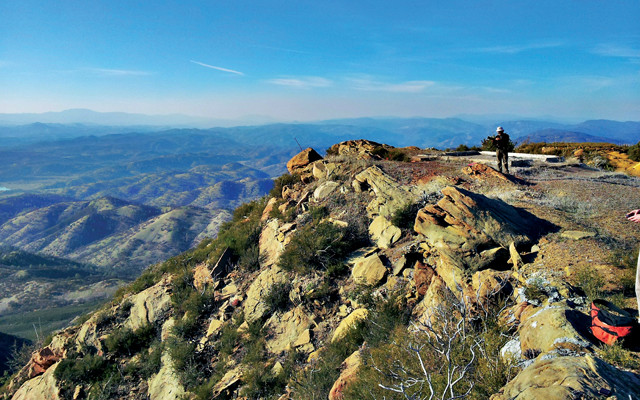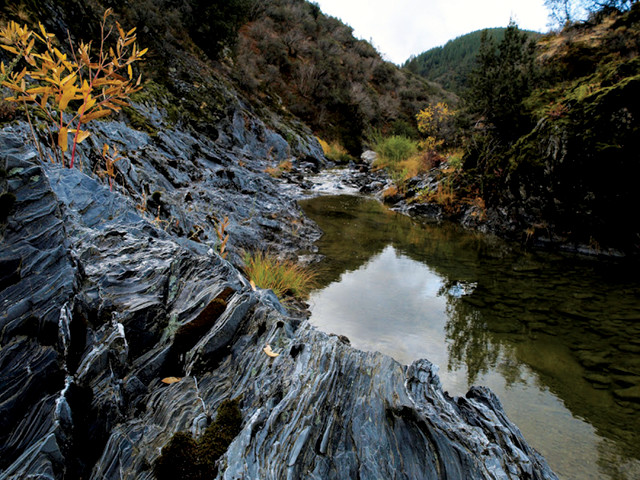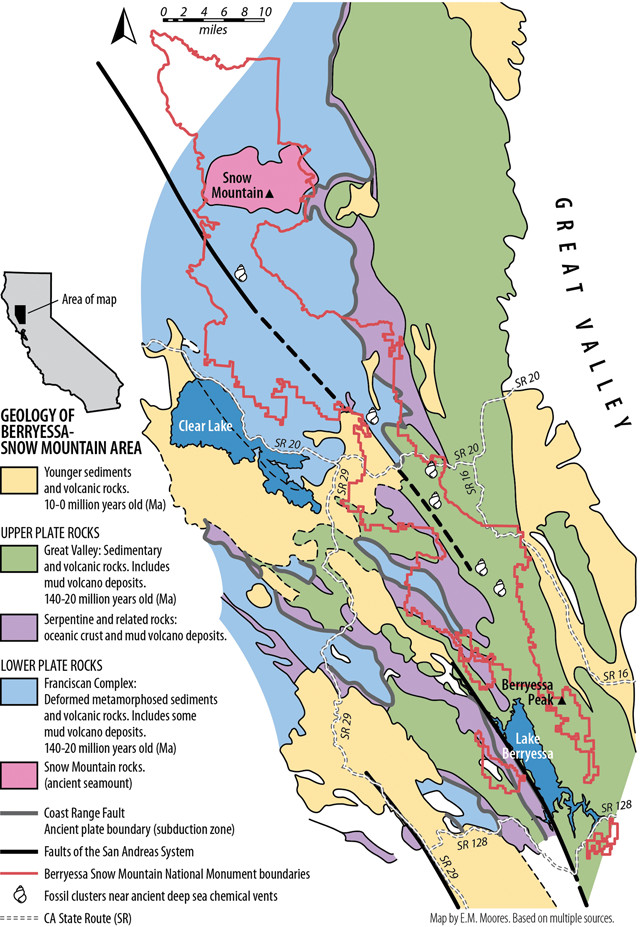
by Eldridge M. Moores and Judith E. Moores Friday, October 23, 2015

The southern end of Berryessa Snow Mountain National Monument includes Berryessa Peak. Credit: Andrew Fulks/Tuleyome, tuleyome.org.
In the Coast Ranges west of Sacramento, Calif., within easy driving distance of San Francisco, lies a wilderness of steep-sided canyons, mountainous terrain and fields of wildflowers. Bald eagles soar overhead, rock layers stand on end, and numerous unique plant species abound. Renowned for its biodiversity, this area is finally garnering deserved appreciation for its world-class geologic features too.
Last summer, President Obama fittingly designated the Berryessa Snow Mountain region of Northern California a national monument. The new monument provides unparalleled access to geologic features associated with an ancient subduction system, where one tectonic plate descended beneath another. Nowhere else in the world is such geology as well preserved or accessible.
The new Berryessa Snow Mountain National Monument encompasses a 134,000-hectare area, extending along the eastern Coast Ranges some 150 kilometers from south of Lake Berryessa northward to the Snow Mountain Wilderness Area. The region has been inhabited for more than 11,000 years by at least eight different Native American tribes; and Spanish, Mexican and Hudson Bay explorers passed through the area in the early 19th century, followed by American miners searching for gold and mercury in the mid- to late 19th century.
The monument is a biological hot spot, with some of the richest species diversity in California. Ecosystems range from chaparral and rolling oak woodlands at lower elevations to old growth Jeffrey pine and incense cedar surrounding bare rocks at high elevations. More than 300 wildlife species live in its oak woodland areas, making this habitat in particular within the Berryessa Snow Mountain region one of the most important in California, according to ecologists. In addition to eagles, visitors may see black bears, mountain lions, elk, and several rare or endangered species, including red-legged frogs, northern spotted owls and martens.

Bedrock in Little Stony Creek. Credit: Jim Rose/Tuleyome, tuleyome.org.
The oak woodlands, as well as aquatic and riparian areas, in the Berryessa region also serve as essential habitat links in California, connecting natural areas in the southeast Coast Ranges and the eastern Bay Area with extensive protected areas farther north and west. Regional landscape connectivity fosters ecological resilience, as climate change requires plant and animal species to adapt to shifting conditions to survive.
The monument’s stunning geology augments its storied history and notable biological diversity. An ancient boundary between the North American Plate and the Farallon Plate descending beneath it is present in the form of the Coast Range Fault. Rocks of the upper plate include Great Valley sedimentary and volcanic rocks overlying remnants of ancient oceanic crust rich in serpentine, a mineral that forms when water reacts with peridotite and similar rocks that originated in Earth’s mantle. The upper plate represents part of the western edge of North America that formed between 140 million and 20 million years ago. Lower plate rocks include the Franciscan Complex: deformed and metamorphosed sedimentary and volcanic rocks that were scraped off the downgoing plate and buried 20 to 30 kilometers beneath the edge of North America, before being uplifted to the surface by erosion. The active San Andreas Fault — a transform fault — developed more recently, modifying the earlier convergent tectonic boundary.

Map of the geology of the national monument. Credit: Eldridge Moores.
The Great Valley sedimentary rocks themselves were deposited originally on top of oceanic crust that had been thrust onto North American continental rocks. Great Valley sediments were laid down in approximately 1- to 1.5-kilometer-deep seas at the edge of North America. Subsequent deformation of Earth’s surface tilted these rocks from their original horizontal position to steeply inclined vertical layers. These rocks are well exposed in the southeast part of the Berryessa Snow Mountain region.
Serpentinites and related rocks of the downgoing plate are remnants of oceanic crust and mantle formed at an oceanic spreading center and subsequently added to the North American continent. Although soils formed from serpentinite rocks lack certain elements required by most plants to live, they are enriched with others, such as chromium, cobalt and nickel, which are harmful to most plants. Thus, the Berryessa Snow Mountain area hosts unique plant species in a variety of landscapes and microclimates adapted to serpentine-derived soils.
Some Franciscan and Great Valley rock units are found in blocky landscapes formed by a chaotic mixture of diverse rock types. Such “mélanges” (after a French word meaning “mixture”) may have formed as deposits of mud volcanoes, a feature perhaps best known from the Marianas Trench. There, fluids derived from the downgoing tectonic plate incorporate blocks of rock as they rise back to the surface and spill over to form submarine earth flows on the ocean floor.
But these mud volcanoes in the Marianas Trench sit thousands of meters beneath the ocean surface and are not directly observable; to study them, geologists employ deep-sea drilling, remote sensing, small deep-diving submarines, or remotely operated vehicles. Ancient deposits in Turkey, Iran, Afghanistan and Pakistan might also have resulted from mud volcanoes. But none is as well documented or accessible as those in the Berryessa Snow Mountain area, where one can walk across the preserved boundary between two former plates and see rocks and geologic structures formed during ancient plate interactions.
Snow Mountain itself represents a special feature. It contains submarine volcanic rocks as old as 140 million years that look as if they were laid down only a few years ago. However, minerals identified in the rocks indicate that they formed as part of a seamount far to the west of California. Over geologic time, the seamount migrated with the downgoing plate to the continental edge, was buried up to 30 kilometers deep, then rose again to Earth’s surface.
The geological and biological settings of the Berryessa region form part of an important scientific story concerning the assembly of California. With the permanent protection of the Berryessa Snow Mountain landscape afforded by the national monument designation, existing and future generations will benefit. Whether you’re a seasoned professional geologist, a geology student looking to see such features for the first time, or someone with a passing interest in cool rocks, this monument deserves a visit.
© 2008-2021. All rights reserved. Any copying, redistribution or retransmission of any of the contents of this service without the expressed written permission of the American Geosciences Institute is expressly prohibited. Click here for all copyright requests.